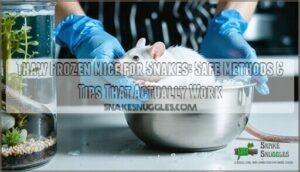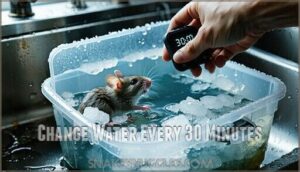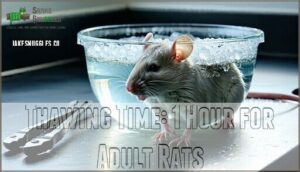This site is supported by our readers. We may earn a commission, at no cost to you, if you purchase through links.
 You’ll want to thaw frozen mice for snakes using one of three safe methods. The slowest but safest route is to pop them in your fridge overnight – mice need about 2 hours, rats take 4-5.
You’ll want to thaw frozen mice for snakes using one of three safe methods. The slowest but safest route is to pop them in your fridge overnight – mice need about 2 hours, rats take 4-5.
If you’re in a hurry, submerge them in cold water for 30 minutes, changing the water halfway through. Once thawed, warm them in lukewarm water for 10-20 minutes so they feel natural to your snake.
Never use your kitchen microwave – that’s just asking for trouble. Remember, once thawed, you can’t hit the reset button and refreeze them.
There are some sneaky mistakes that could put your snake at risk.
Table Of Contents
- Key Takeaways
- Refrigerator Thawing
- Cold Water Thawing
- Warming Thawed Mice
- Mistakes to Avoid
- General Considerations
- Frequently Asked Questions (FAQs)
- How to defrost frozen mice for snake?
- How to get a snake to eat frozen thawed?
- How long to leave a thawed mouse in a snake cage?
- How to defrost pinkies for snakes?
- How to defrost frozen mice for snakes?
- Can you thaw and refreeze mice for snakes?
- How long can I leave a thawed mouse in my snakes cage?
- How do you defrost pinkies for snakes?
- How do you thaw frozen mice?
- Are frozen/thawed mice good for snakes & reptiles?
- Conclusion
Key Takeaways
- You’ll get the safest results by thawing frozen mice in your refrigerator overnight, which takes about 2 hours for mice and 4-5 hours for rats while preventing dangerous bacterial growth.
- If you’re in a rush, submerge the frozen mouse in cold water for 30 minutes, changing the water halfway through, then warm it in lukewarm water for 10-20 minutes before feeding.
- Never use your kitchen microwave to thaw mice since it creates dangerous hot spots and cross-contamination risks – stick to refrigerator or cold water methods only.
- You can’t refreeze mice once they’ve been thawed, and you must feed them within 24 hours to prevent bacterial growth that could make your snake sick.
Refrigerator Thawing
If you’re not in a hurry and want the safest thawing method, toss that frozen mouse in your fridge the night before feeding time.
This slow-and-steady approach keeps bacteria at bay while your snake’s dinner defrosts perfectly, though you’ll need to plan ahead since mice take about 2 hours and rats need 4-5 hours to fully thaw.
Place Frozen Mice in Refrigerator Overnight
Overnight safety becomes your best friend when you’re dealing with frozen mice. Simply place them in your refrigerator and let time work its magic. This method prevents bacterial growth while maintaining the prey’s nutritional value at ideal fridge temperature.
Here’s why refrigerator thawing wins every time:
- Zero bacterial growth – Cold temperatures keep nasty microbes at bay
- Preserves nutrients – Your snake gets maximum nutritional benefits
- Maintains natural scent – Attracts your snake like a dinner bell
- Complete control – No guesswork, just reliable thawing duration
This defrosting method gives you peace of mind and perfectly prepared snake food. This typically takes 12-24 hours.
Thawing Time: 2 Hours for Mice, 4-5 Hours for Rats
After you’ve placed your frozen rodents in the fridge, timing becomes vital for safe snake food preparation.
Mice need about 2 hours for complete defrosting, while rats require 4-5 hours due to their larger size.
This gradual thawing process maintains nutritional integrity and prevents bacterial growth.
Don’t rush—proper snake feeding thawing time guarantees your pet gets a safe, wholesome meal.
Cold Water Thawing
If you’re in a hurry and need your frozen mouse ready faster than overnight thawing, cold water‘s your best friend.
This method gets the job done in about an hour, but you’ll need to babysit it a bit by changing the water every thirty minutes.
Place Frozen Mice in Cold Water for 30 Minutes
When refrigerator thawing takes too long, cold water offers a quicker solution.
Fill a clean bowl with cool water temperature – not icy cold. Submerge your frozen mice completely.
The thawing duration for mice is typically 30 minutes, while larger rodents need longer.
This method maintains prey integrity while ensuring snake safety. Cold water prevents bacterial concerns that come with room temperature defrosting rodents.
Perfect for snake feeding thawing when you’re short on time.
Change Water Every 30 Minutes
When thawing frozen mice using cold water, you’ll need to swap out that water every 30 minutes. Fresh water keeps the water temperature consistent and prevents bacterial growth from turning your snake’s dinner into a health hazard.
Here’s your game plan for safe snake feeding thawing methods:
- Set a timer for 30-minute intervals
- Drain old water completely from container
- Refill with fresh cold water
- Check mouse for complete thawing progress
This simple routine maintains water quality and proper thawing speed while keeping harmful bacteria at bay.
Thawing Time: 1 Hour for Adult Rats
When thawing frozen rats using cold water methods, you’ll need about an hour for complete defrosting. Adult rats are substantially larger than mice, so they require extra time to reach proper temperature throughout.
The rat thawing speed depends on consistent water temperature impact and regular monitoring of the thawing process.
Here’s what makes the difference in thawing consistency importance:
- Size variations matter: Larger rats need more patience than smaller prey items
- Regular checks prevent problems: Monitor thawing to guarantee even temperature distribution
Change that cold water every thirty minutes—it’s your best defense against bacterial growth while maintaining best thawing methods for safe snake feeding.
Using tongs helps with mimicking natural movement when feeding.
Warming Thawed Mice
Your snake won’t touch a cold mouse, and who can blame them?
Your snake’s got standards – cold dinner just isn’t going to cut it!
You’ll need to warm that thawed mouse in lukewarm water for 10-20 minutes, making it feel like fresh prey that’ll actually tempt your snake to eat.
Warm Thawed Mice in Warm Water for 10-20 Minutes
Once you’ve thawed your snake food, it’s time to warm things up. Place the rodent in warm water for 10-20 minutes – this mimics live prey’s body temperature and triggers your snake’s feeding response.
Don’t overdo it though, as excessive heat speeds up decay. To guarantee safety, always follow storage and labeling guidelines to track freshness.
| Factor | Recommendation | Why It Matters |
|---|---|---|
| Optimal Temperature | Lukewarm water (100-105°F) | Prevents overheating and bacterial growth |
| Warming Duration | 10-20 minutes maximum | Balances warmth with food safety |
| Water Quality | Clean, fresh water only | Maintains hygiene practices during preparation |
Use feeding forceps for handling – trust me, your snake preference matters here!
Use Mice Shortly After Thawing and Warming
Once your mouse feels warm to touch, Immediate Feeding becomes your top priority. Freshness Matters because bacterial growth accelerates rapidly at room temperature, compromising Nutritional Integrity and Palatability Factors.
You’ve got a narrow window here—Decay Prevention starts the moment you finish thawing frozen mice.
- Feed within 30 minutes of warming for ideal snake feeding thawing results
- Room temperature snake feeding thawing time shouldn’t exceed one hour maximum
- Proper snake feeding thawing temperature maintains prey’s natural scent appeal
Internal Organs and Waste Decay Rapidly After Thawing
Once thawing frozen mice begins, you’re racing against time.
Time is your enemy once those frozen mice start thawing—bacteria won’t wait.
Bacterial growth explodes within hours, turning healthy prey into dangerous meals.
Organ liquefaction starts immediately, creating perfect breeding grounds for toxin production.
This rapid decay causes nutritional loss and threatens snake health through poisoning or diseases.
Don’t mess around—immediate feeding after warming prevents these nasty complications.
Your snake’s life literally depends on fresh, properly timed meals.
Mistakes to Avoid
Even the most experienced snake owners can mess up when thawing mice, and these mistakes can put your pet at risk.
You’ll want to avoid a few common errors that could make your snake sick or even hurt them.
Do Not Thaw in Microwaves Used for Human Food
Your kitchen microwave might seem like the perfect shortcut, but it’s a recipe for disaster when thawing frozen mice.
Here’s why you should avoid microwave contamination at all costs:
- Uneven heating creates dangerous hot spots that can explode
- Bacteria growth thrives in inconsistent temperatures
- Nutrient loss occurs from rapid temperature changes
Cross-contamination with human food poses serious safety concerns for your family’s health and your snake’s well-being.
Thawed Mice Under Refrigeration Can Be Re-frozen
You can technically refreeze mice thawed in your fridge, but it’s like playing Russian roulette with your snake’s dinner.
While refrigeration slows bacterial growth, refreezing dangers multiply with each cycle, creating potential food safety nightmares.
- Nutritional degradation accelerates with each freeze-thaw cycle, robbing your snake of essential nutrients
- Bacterial growth continues even during refrigeration, potentially harboring dangerous pathogens like Salmonella
- Safety implications include increased contamination risks that could harm both you and your reptile
- Ethical considerations matter – repeatedly frozen prey loses quality your snake deserves
- Thawing safety demands single-use protocols for ideal snake feeding practices
Thawed Mice in Cold Water Should Not Be Re-frozen
Skip refreezing mice you’ve thawed in cold water – it’s a recipe for trouble.
This method exposes the mice to bacterial growth that makes refreezing risky for your snake’s health. Cold water thawing breaks down food safety barriers, creating nutritional loss and contamination issues.
Instead, find other methods for thawing or feed immediately. When thawing safety matters, stick to refrigerator methods for frozen mice if you need refreezing flexibility.
General Considerations
Before you start thawing mice, you’ll want to set up a clean, organized system that keeps your snake safe and your kitchen sanitary.
Think of it like prepping for cooking dinner—you wouldn’t use dirty dishes or mix raw chicken with your salad bowl, and the same rules apply when handling frozen rodents.
Repackage Frozen Mice in Clean Bags
Smart snake owners know that proper bag material makes all the difference. Repackage your frozen mice in fresh Ziploc bags immediately after purchase.
Your labeling practices should include date and size for easy identification. This freezer organization system prevents bacteria buildup and maintains hygiene standards.
Some owners find Ziploc bags useful for storing feeder mice. Store them for maximum six months storage duration to guarantee food safety.
Clean bags protect against contamination that older packaging might harbor, keeping your hygiene practices on point.
Use Bowls Designated for Mouse Thawing Only
Once you’ve got your frozen mice properly bagged, you’ll need dedicated bowls for thawing.
Don’t use your regular kitchen dishes – that’s asking for trouble with cross-contamination risks. Pick up some cheap plastic or stainless steel containers and label them "snake food only."
Store these bowl material options away from your regular kitchenware. You can find specialized thawing bowls available for this purpose.
Following proper cleaning protocols and hygiene practices keeps bacterial contamination at bay. Your snake feeding thawing setup stays clean, and your family dinnerware stays safe from defrosting methods mishaps.
Frozen Mice May Contain Bacteria
You’re handling dead animals, so bacteria comes with the territory. Frozen mice harbor dangerous microorganisms like Salmonella and E. coli that survive freezing temperatures.
Here’s your bacterial contamination risks protection plan:
- Wear disposable gloves during all snake feeding thawing processes
- Disinfect thawing tools with bleach solution after each use
- Store frozen mice separately from human food using storage best practices
- Inspect for discoloration as visual inspection signs of spoilage
Smart snake feeding safety prevents nasty surprises. To guarantee safety, consider gradual thawing methods.
Frequently Asked Questions (FAQs)
How to defrost frozen mice for snake?
Like defrosting a Thanksgiving turkey, patience pays off.
Place your frozen mouse in the fridge overnight, then warm it in lukewarm water for 10-15 minutes.
You’ll have a perfectly thawed, body-temperature meal ready.
How to get a snake to eat frozen thawed?
Warm your thawed mouse in lukewarm water for 10-15 minutes, then use feeding tongs to wiggle it naturally.
If your snake still refuses, try "braining" the mouse or switching feeding locations for better results.
How long to leave a thawed mouse in a snake cage?
Here’s an alarming fact: 70% of snake owners leave prey too long, risking bacterial growth.
You should remove uneaten thawed mice after 24 hours max.
Don’t let it sit longer—spoiled food can seriously harm your snake’s health.
How to defrost pinkies for snakes?
Place pinkies in a sealed bag, then submerge in cold water for 30-45 minutes. Once thawed, warm them in lukewarm water for 10 minutes before feeding to guarantee they’re body temperature.
How to defrost frozen mice for snakes?
Thawing frozen mice is like bringing a popsicle back to life. You’ll refrigerate overnight or use cold water for quicker results, then warm in lukewarm water before feeding your snake.
Can you thaw and refreeze mice for snakes?
Never refreeze thawed mice – it’s dangerous for your snake.
Once you’ve thawed a mouse, you’ve got 24 hours to feed it or toss it.
Refreezing creates harmful bacteria that’ll make your snake sick.
How long can I leave a thawed mouse in my snakes cage?
Time’s ticking when you’ve got a thawed mouse sitting in your snake’s cage.
You shouldn’t leave it there longer than 24 hours max, but honestly, remove it after 12 hours to prevent spoilage and bacteria growth.
How do you defrost pinkies for snakes?
You’ll want to move those frozen pinkies to your fridge overnight.
Then warm them in lukewarm water for about 10-15 minutes before feeding.
Don’t rush it with hot water or microwaving.
How do you thaw frozen mice?
Frozen prey takes roughly 2-4 hours to defrost properly.
You’ll want to thaw mice in cold water first, then warm them in lukewarm water for 10-15 minutes before feeding time arrives.
Are frozen/thawed mice good for snakes & reptiles?
You’ll find frozen/thawed mice are safer than live prey since they can’t bite or scratch your snake. They’re also convenient, cost-effective, and reduce disease risk while providing excellent nutrition.
Conclusion
Remember when caring for pets used to mean just filling a food bowl?
Now you’re mastering the art of safely preparing frozen prey for your serpent friend. Learning to thaw frozen mice for snakes properly isn’t just about convenience—it’s about keeping your snake healthy and happy.
Stick to the fridge or cold water methods, warm before serving, and never refreeze.
Your snake will thank you with better appetite and fewer health issues down the road.














